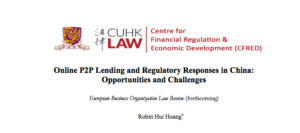
Research Paper Examines the Impact of China’s New Regulatory Regime for P2P Lenders
by Fintech News Hong Kong August 2, 2017China, the undisputed fintech leader, has seen its online lending market grow rapidly since the late 2000s, fueled by the high online penetration rate and the encouragement of the Chinese government, which sees Internet finance as an important vehicle to foster a more inclusive financial system in China.
But the growth of online lending has also given rise to many gaping problems including numerous scams. Since 2011, 3,556 platforms have collapsed according to Online Lending House, a service that tracks the sector. In third of the cases, law enforcement agencies closed the platforms or their owners or managers simply disappeared.
In response, Chinese regulators have been introducing rulings since 2016 to monitor and regulate peer-to-peer lending, a sector that had CNY 816 billion (US$118 billion) in loans outstanding by the end of 2016, according to the Financial Times.
China’s recently established regulatory regime for online lending introduces a number of significant changes such as the restriction on the business model that can be adopted by platforms, registration requirement, custodian requirement, information disclosure requirement and lending limits.
The new regime is set to have far-reaching implications, including a reshuffling of the market and more collaboration between online lending platforms and traditional banks.
 In a new research paper, Robin Hui Huang of the Chinese University of Hong Kong, Faculty of Law, examines the extent of the new regime. In particular, the paper looks at how the framework is likely to achieve a proper balance between its two main goals, namely facilitating the growth of the online lending market and protecting consumers.
In a new research paper, Robin Hui Huang of the Chinese University of Hong Kong, Faculty of Law, examines the extent of the new regime. In particular, the paper looks at how the framework is likely to achieve a proper balance between its two main goals, namely facilitating the growth of the online lending market and protecting consumers.
“The challenge of finding the best possible way to regulate online lending consists of nothing more than trying to strike a balance between the two regulatory objectives. Importantly, the balance is a delicate one and needs to be adjusted according to the local conditions,” the paper reads.
“Based on a comparative analysis of the Chinese experience with those in other jurisdictions such as the US, the UK and Hong Kong, it is submitted that the Chinese regime is generally sound and less onerous. […] It remains to be seen whether the regulatory regime will function as efficiently in practice.”
A new era for China’s P2P lending industry
The rulings have made up “a relatively complete regulatory regime for online lending, which will have far reaching implications.” The regime will “usher in a new era for the development of China’s online lending market, with platforms facing a period of reshuffling.”
China’s online lending market underwent a phase of explosive growth in the past years, with platforms having mushroomed across the country. In 2015, for instance, the number of platforms grew by almost 40%.
But several scandals as well as tighter regulation of the market have led to an overall slow down. For instance, in December 2015, it was exposed that online lending platform Fanya Metal Exchange had illegally raised more than CNY 40 billion. Later that month, it was unveiled that Shenzhen-based platform Ezubao had reportedly defrauded investors of more than CNY 50 billion in about one and a half year. As of June 2016, there were a total of 1,778 problematic platforms, representing 43.1% of all online lenders in China, according to the China Banking Regulatory Commission.
It is estimated that more than half of China’s online lending platforms will have to change their business models because of the new regulatory regime. “Coupled with the new requirements in relation to custodian, information disclosure and registration, it is likely that many small and weak platforms with poor internal control mechanisms may be driven out of the market,” the report says.
“In principle, this is exactly what is needed, as those platforms are more likely to have problems in practice. From a comparative perspective, there are simply too many online lending platforms in China and the market needs to be more concentrated to allow the emergence of online lending giants which will become national champions and even compete on the international level.”
The paper also claims that the regime will provide opportunities for more collaboration between online lenders and banks, as traditional financial institutions will be more willing to provide custodian services to these platforms. “This actually presents a very attractive new business opportunity for banks whose traditional source of revenue, namely the spread between deposit rate and loan rate, has been narrowing significantly in recent years.”
Featured image: Shanghai, Skyline, via Pixabay.








